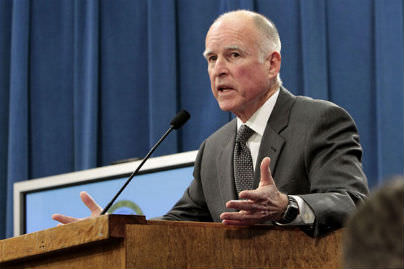California Party Time
Sacramento spends its tax revenue gusher like there’s no
tomorrow.
WSJ Opinion, May 31, 2015
These are hard times for the blue-state
governing model of high taxes and public unions—see Illinois, Connecticut and
Maryland. But our friends on the left ignore these states and tout California
as their real model, as Sacramento celebrates record tax revenue. So it’s worth
noting that the Golden State may be repeating the fiscal mistakes it made
before its last economic bust.
There’s no doubt the state government is on a
high, with Governor Jerry Brown forecasting $6.7 billion in additional revenue
beyond his January projections due to growth in capital gains and incomes among
high earners. Over four years general fund revenues have risen by 40% to $117.3
billion as income-tax collections surged 55%.
This follows what has turned out to be one of
the most fortuitously timed tax increases in history. Mr. Brown’s 2012 ballot
measure retroactively raised taxes on individuals earning more than $250,000
and increased the top rate to 13.3% from 10.3% for those making more than $1
million. The measure passed amid the Internet boom and stock market rise.
No one wants to mention, however, that the tax
hike doubled down on the state’s top-heavy tax structure that produces huge
revenue swings. The top 1% of taxpayers—those earning more than $525,000—paid
over 50% of all California income taxes in 2012 while the bottom four quintiles
earning less than $90,000 paid a mere 10%. The Golden State has lost
middle-income jobs in manufacturing to other lower-taxing Western states, but
it has assets like Silicon Valley that other blue states don’t.
The resulting revenue boom has politicians
partying like it’s 1999, the height of the dot-com bubble. The boom has been
especially sweet for teachers unions because under the state constitution
schools are entitled to most of the haul. Over the past four years state
spending on K-12 and community colleges has grown by 45% to $68 billion this
year.
But now other liberal interest groups want to
join the party. So Mr. Brown is proposing to extend Medicaid to illegal
immigrants granted permanent residency by President Obama. California’s
Medicaid expansion under ObamaCare has already added four million beneficiaries
at a cost of $17 billion. National taxpayers are picking up $15.5 billion of
the tab for now, but California’s share will grow after 2016.
Mr. Brown also wants to create another
entitlement by inaugurating a state version of the earned-income tax credit for
two million low-income Californians. That comes on top of next year’s increase
in the minimum wage to $10 an hour, and $15 an hour by 2020 in Los Angeles.
Yet despite the government’s efforts to help
the poor, California has the nation’s highest poverty rate at 23.4%. And
nowhere in the U.S. save perhaps New York City is income inequality greater
than San Francisco, which has been a hothouse for progressive policies such as
a $15 minimum wage and mandated paid sick leave. All that income redistribution
doesn’t seem to be the secret to equality.
Meantime, projected revenues from California’s
cap-and-trade auctions have swelled by 150% in the last year to $2.2 billion.
Mr. Brown wants to spend $400 million of that windfall on affordable housing;
$350 million on low-carbon transportation (i.e., electric car subsidies that go
mainly to the well off); $365 million on public transit and intercity rail; and
$500 million on the L.A. to San Francisco bullet train that is already short of
funding.
***
The danger is that this gusher of new spending
will set up the state for another budget bust. Last November voters did approve
a ballot referendum aimed at imposing some spending discipline, strengthening
the porous rainy day fund. Under the new law’s formula, the state must spend
$1.9 billion this year to pay down “debts and liabilities.”
But Mr. Brown has construed it broadly to
include payments to schools and special funds that politicians had previously
raided. He’d also create a new liability by proposing to seize $96 million from
the rainy day fund to shore up University of California pensions. Yet Mr.
Brown’s budget doesn’t even begin paying down the $191 billion unfunded
liability for state worker and teacher retirement benefits.
At the end of 2015 the rainy day fund will
have a meager $3.5 billion, and the Governor cautions that the “budget remains
precariously balanced and faces the prospect of deficits in succeeding years.”
Last year the state Legislative Analyst’s Office warned that a modest dip in
income growth could trigger multibillion-dollar deficits due to built-in
spending increases, particularly in education.
The paradox of Jerry Brown has always been
that he’s smart enough to recognize the severity of the state’s fiscal
problems, yet he can’t seem to restrain his prodigal legislature or even help
himself. The revenue boom is making California’s economy and budget look better
than they are. The reckoning will arrive when the next economic downturn does.











 Despite California’s
Despite California’s